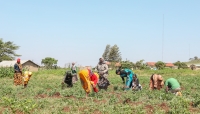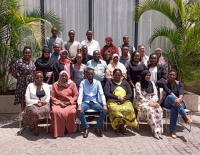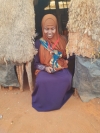.
![]()
Thursday, 09 May 2024 15:24
PRESS RELEASE - Escalating Humanitarian Crisis Amid Rising Floods in the ASAL Region
Escalating Humanitarian Crisis Amid Rising Floods in the ASAL Region Joint media statement by the ASAL Humanitarian Network (AHN) FOR IMMEDIATE RELEASE Nairobi, May 10th 2024 - Kenya is currently experiencing heavy rainfall and subsequent floods and the ASAL region is adversely affected with thousands of households displaced and livelihoods lost. The heavy rainfall has further caused massive destruction of property and critical infrastructure (road, bridges, schools, health centers and sanitation facilities), extensive displacement of populations, high risk of water-borne diseases, destruction of farmlands and death of livestock.
Read 22 times
Sunday, 26 November 2023 16:58
Humanitarian crisis deepens as flooding escalates in ASAL Kenya: AHN Call for Collective and Urgent Action
Kenya is once more at the forefront of a climatic crisis. Heavy rainfall due to the El Niño climatic phenomenon as well as the enhanced Indian Ocean Dipole both are combining to make this rainy season wetter than average according to the Kenya Meteorological Department. These wet conditions are predicted to continue until February 2024 with rainfall increasing, especially in the northern part of Kenya in Isiolo, and Marsabit counties and along the coast up towards the North eastern counties of Garissa, Wajir and Mandera[1] some of the counties in the ASAL of Kenya which have been greatly affected.
Read 646 times
Wednesday, 15 November 2023 12:54
Community-led transformation: Empowering people to drive change and build resilience
By Sarah Ndonye - ASAL Humanitarian Network The world is facing unique challenges that affect the productivity and sustainability of the economic and social systems. One of the current pressing global issue, among others, is to guarantee food security and build resilience for a growing population while ensuring sustainable progress and development that is inclusive. However, Climate change and global warming have posed a challenge to achieving food security and sustainable development and this has been further exacerbated by conflicts, rising food prices and other activities that damage ecosystem services that many communities depend on for their economic and social progression. The economic and social impacts of climate change coupled with other regional and global dynamics have compromised the quality of livelihoods and coping ability among the ASAL populations further amplifying their ability to cope. Kenya, and in particular the ASAL areas are equally prone to natural disasters like droughts,…
Read 358 times
Thursday, 09 November 2023 14:24
Empowering Women Rights Organisations to implement community-led responses
In the heart of Nairobi Kenya, AHN Women Rights Organisations actively participated in the sclr co-design workshop. Participants of this training were drawn from the local WROs in the network representing Tana river, Garissa, Marsabit, Samburu, West pokot and Isiolo counties. The four day workshop was funded by Center for Disaster Philanthropy - (CDP), one of the latest AHN partners. The Survivor and Community-led crisis response (sclr) approach places the crisis-affected communities at the center of the response and gives them the authority and resources to take charge of their own response. The primary goal of the SCLR is to strengthen the initiatives of crisis-affected communities to help each other (Mutual aid), survive the crisis with dignity and promote communal wellbeing by addressing the root causes of vulnerability. The workshop’s objective was to enhance the capacity of these organisations to collectively design and implement community-led responses that focus on empowering…
Read 181 times
Thursday, 09 November 2023 14:08
Advocating for Climate Action: AHN at the Africa Climate Summit media roundtable
The ASAL Humanitarian Network in close partnership with Oxfam in Kenya participated in a media roundtable during the Africa Climate Summit held in Nairobi Kenya in September 2023. Ahmed Ibrahim, Convener of the network participated as a panelist during this media event. The primary focus of this discussion revolved around the far-reaching impact of the climate induced hunger crisis in Africa and the urgent need for increased national and global investment in climate action particularly within the Africa context. ASAL Kenya bears the greatest burden of the climate crisis and the members of the ASAL Humanitarian Networks are committed to taking a central role to influence climate action at the local and national levels. During the event, the AHN highlighted the following key points: 1) The number of people affected by the climate crisis in ASAL Kenya in ASAL Kenya has doubled leading to a disruption in their coping mechanisms…
Read 153 times
Wednesday, 08 November 2023 10:43
Protecting Livelihoods and Building Resilience in Garissa County
By Halima Ali, Womankind Kenya, Garissa Malnutrition has emerged as a pressing concern in drought-affected regions, primarily due to the limited essential resources like clean water and adequate food. Droughts intensify malnutrition due to crop failures, livestock losses, and reduced access to clean water sources, all of which collectively contribute to food insecurity and malnutrition. In response to this critical challenge, WOKIKE with the invaluable support od USAID’s Bureau for Humanitarian Assistance (USAID/BHA) initiated a comprehensive assessment of the affected population within communities in Sangailu, Hulugho Sub county.
Read 207 times
Wednesday, 08 November 2023 08:25
Agriculture as an alternative livelihood for pastoralist communities: Story of Ajikon from Turkana
Ricky Sumbu – Sustainable Approaches for Community Empowerment SAPCONE, Turkana County. Ajikon Ereng, is a 38-year-old resident of Naotin in Turkana central sub-county. Due to the drought of 2022, Ajikon, like many other residents in her village faced much difficulty in accessing nutritious food and safe water. For a community that has historically practiced pastoralism as a source of livelihood, the lack of pasture and the massive loss of livestock further intensified the desperation.
Read 257 times
Thursday, 02 November 2023 13:01
From desolation to hope: PACIDA’s Drought and Recovery Response in Demo village in Marsabit
Kirera Magana Pastoralist Community Initiative and Development Assistance (PACIDA), Marsabit Located in the far-eastern side of North Horr Sub-County, Turbi Ward, Demo Village is flat and rocky. Residents of this village have borne the brunt of the 2021 – 2023 drought that has been described by experts as the worst to hit Kenya and indeed the Horn of Africa in four decades. For months, the village has been inundated with carcasses of camels, goats and cows strewn over its plains. Scavengers – vultures, hyenas and crows- have been feasting on the communal assets. This has been a heart-breaking sight for the residents who have seen their generational wealth disappear in months as a result of the vagaries of climate change.
Read 156 times
Thursday, 02 November 2023 12:35
Empowering Kabo Village with Solar-Driven Water Pumping for Sustainable Water Access.
Stephanie Machua - Nomadic Assistance for Peace and Development (NAPAD), Mandera County. Millions of people around the world live with limited access to water. In many communities, ground water is extracted through water pumps powered by diesel. However, these systems not only require costly, regular servicing along with the purchasing of expensive fuel, they emit carbon dioxide, polluting the environment. In Kabo Village in Mandera County, the situation was no different. Kabo is a remote village in Lafey subcounty, Mandera County. The community here relied on a diesel driven water pumping system to access water for both domestic and household use, as well as rain-fed water. Whenever the pumping system would break down, it left the community with very few options for finding water, which was made even harder due to the drought conditions, high water costs from private water vendors, and the risks of insecurity and gender-based violence affecting…
Read 148 times
More...
Thursday, 02 November 2023 11:58
Desert Oasis: Community-led resilience building through agriculture in Hurri hills, Marsabit
Indigenous Resource Management Organization (IREMO), Marsabit County The story of Hurri Hills Farmer Field School, based in the expansive Chalbi desert in Marsabit county, is a testament of resilience and adaptability in the face of the drought adversity. An emergent group of 33 farmers comprising of 15 women and 18 men who were severely affected by the effects of the prolonged drought. Residents who lost all their herds of cattle that they had relied on for their livelihood as pastoralists taking a devastating toll on their once thriving herds. During this time, Marsabit County was in the grip of unprecedented drought occasioned by four consecutive failed rainy seasons. All indicators including food security collapsed and deteriorated to emergency drought phase. The local communities’ coping strategies overstretched to precarious levels characterized by food insecurity, acute water shortage, increased temperatures and the degradation of rangelands.
Read 236 times
Tuesday, 31 October 2023 09:07
Resilience Rising: Transforming Lives Through Sustainable Water Solutions in Marsabit County
Susan Wamuyu, Strategies for Northern Development (SND), Marsabit County. In February 2022, the NDMA Report for Northern Kenya revealed dire statistics: Marsabit County faced acute water scarcity due to consecutive rainy season failures. Household and livestock watering distances were 11.8km and 33.2km, respectively, with 95% of surface water sources depleted. Approximately 10% of boreholes malfunctioned due to part shortages, worsened by clustered livestock at watering spots, further intensifying the drought crisis.
Read 234 times
Tuesday, 31 October 2023 08:50
Bridging livelihood gaps: Impact of Multi-Purpose Cash Response to Crisis-Affected Communities
Stephanie Machua - Nomadic Assistance for Peace and Development (NAPAD), Mandera County. In May 2023, the National Drought Early Warning Bulletin reported that in 17 ASAL counties had returned to the normal phase owing to the rains received between March to May. In spite of these rains, the threat of malnutrition still loomed large due to the prolonged period between drought recovery and food availability met Maryama Ibrahim Alinur, a resilient 30-year-old mother of five living in Funan Teso village, nestled within the Kiliwehiri sub-county of Mandera County. Like many families in the region, her life had been troubled with hardships caused by the relentless drought that plagued the region between 2020 and 2023.
Read 299 times
Wednesday, 02 August 2023 10:43
Better access to safe water has put smiles on ASAL households
Access to clean, safe water and sanitation is a fundamental human right and a component of ensuring a dignified life especially for people affected by and made vulnerable by emergencies such as drought. Proper access to clean water for household and animal use has been a great challenge especially for women and girls who have to walk close to ten kms daily to fetch water. This puts them at risk of attacks due to insecurity and also compromises their time in school or participating in Income Generating Activities. “Access to clean water was a difficult task especially to the village women as there was no separate water drawing point for households and animals. Now, I can access water anytime, without worrying of the long distance. Currently I am spending only Sh 5 (USD 0.041) for a 20-liter clean jerrycan compared to Sh 10 (USD 0.082) for the same jerrycan before”.…
Read 262 times
Our Work
Recent Post
Humanitarian crisis intensifies as flooding escalates in ASAL Kenya: AHN Call for Collective and Urgent Action
28 November 2023
Community-led transformation: Empowering people to drive change and build resilience
15 November 2023
Women, Children Worst Hit By Drought In The Country
21 February 2023
Humanitarian Network Wahimiza Serikali Kutatua Hali ya Ukame Nchin
21 November 2022












